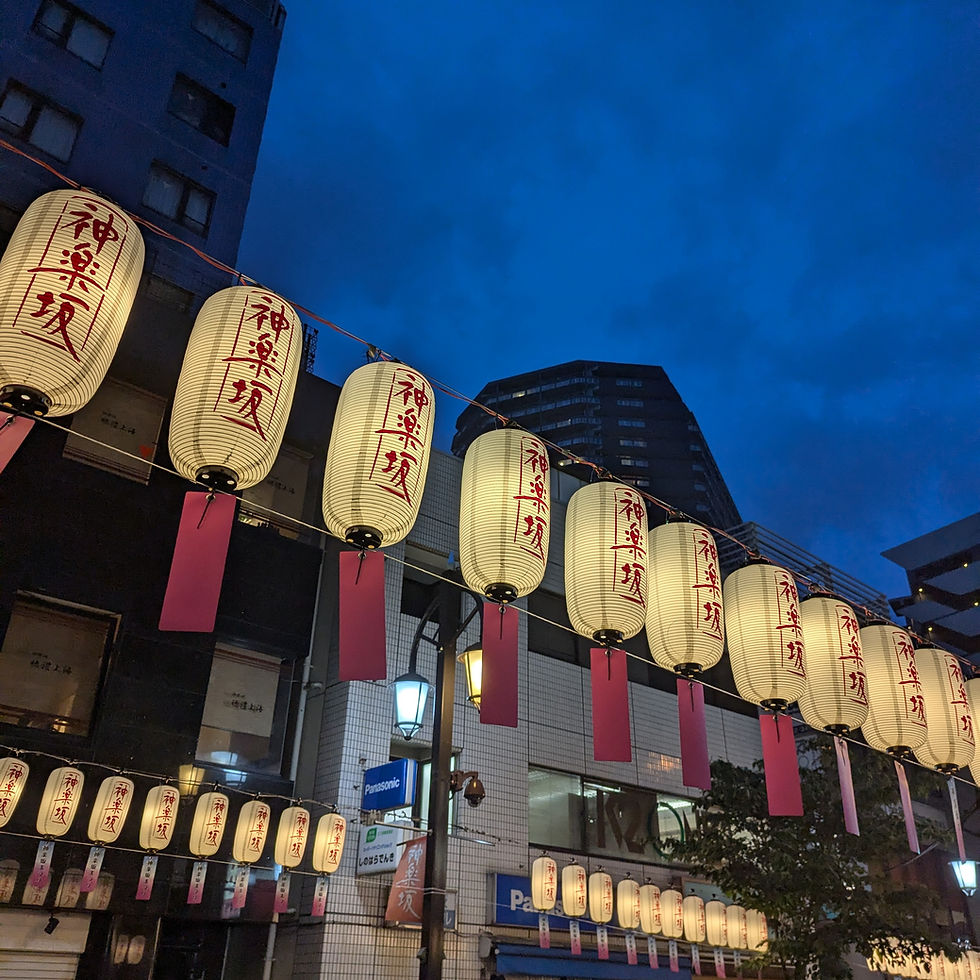Why Do We Feel Both 'Iki' and 'Wabi-Sabi' in Tokyo's Kagurazaka?
- Shinya Yamada
- Aug 18, 2024
- 4 min read
Updated: Sep 24, 2024

Embracing Iki: The Thoughtful Development of Kagurazaka
Kagurazaka is a neighborhood known for its 'Iki (Sophisticated).' The residents of Kagurazaka have established a town development plan called the "Kagurazaka Machizukuri Kensho," which aims to create "The town of Iki where tradition and modernity meet – Kagurazaka."
The basic policies for town development include creating "a town where commerce and residential areas coexist," "a town adorned with traditional charm," and "a town that is enjoyable to stroll through." Even the organization responsible for the town’s development is named the "NPO Iki-na Machizukuri Club" (NPO Sophisticated Town Development Club).

Iki: The Timeless Elegance of Kagurazaka's Edo and French Influences
The concept of 'Iki' is an aesthetic that developed during the Edo period. Under restrictions such as luxury bans, a sophisticated urban culture emerged, characterized by understated elegance, like the Edo Komon (a type of traditional patterned fabric). 'Iki' refers to beauty that is simple yet exudes taste and individuality.
Kagurazaka, a street built by the third shogun, Tokugawa Iemitsu, still retains its Edo-period layout and is a neighborhood steeped in Edo culture. The long-standing geisha district culture also remains. With the influence of French culture, thanks to the presence of the Institut Français, the entire neighborhood has an air of subtle sophistication – truly a town embodying 'Iki.'

Discovering 'Wabi-Sabi' in the Heart of Kagurazaka's 'Iki
Having lived in Kagurazaka for many years, I also sense 'Wabi-Sabi' in this town of 'Iki.' 'Wabi-Sabi' is an aesthetic that finds value in the passage of time, the changes in nature, and the beauty of imperfection. It is particularly influenced by the tea ceremony and Zen, emphasizing spiritual richness and inner peace over material wealth. While 'Iki' and 'Wabi-Sabi' share a common focus on simplicity and inner beauty, 'Iki' includes elements of external style and allure, which 'Wabi-Sabi' does not.

Temples and Tea: The Dual Essence of Tokyo's Kagurazaka's 'Iki' and 'Wabi-Sabi'
One reason why we can feel both 'Iki' and 'Wabi-Sabi' in Tokyo's Kagurazaka is that it is also a temple town. In addition to the "Bishamonten Zenkokuji Temple," a temple that laid the foundation for Kagurazaka's development and still attracts many visitors today, there was also the "Gyoganji Temple," said to be the birthplace of the Kagurazaka Geisha. Kagurazaka even has a district called Yokoteda-cho (Many Temple Town), named after the many temples that once gathered there. Moreover, a little further from Kagurazaka, you’ll find "Denchuji Temple," a Zen temple with about 400 years of history, where our company offers Zen meditation experiences.

Additionally, the Tokyo Dojo of Ura-Senke, one of the main schools for tea ceremonies, is located near Kagurazaka (Ichigaya Kaga-cho 2-5-23, Shinjuku Ward). Perhaps because of this, Kagurazaka has many tea rooms.
The oldest dining establishment in Kagurazaka, the eel restaurant "Shimakin" (established in 1869), has a tea room, as does Denchuji, mentioned earlier. The long-established Japanese confectionery "Baika-tei," which will be offering our upcoming wagashi-making classes, has also built a wagashi workshop that doubles as a tea room. There are also cafes like "Kagurazaka Wa-cha" and tea rooms called "Bon" where tea ceremony classes are held. Even the French restaurant "HASABON" has a tea room. Incidentally, "Hasabon" refers to a broken mortar that is no longer usable, a Zen term symbolizing a mature state of mind.
Across from Zenkokuji Temple is the long-established tea shop 'Rakuzan.' The fragrant aroma of tea roasted by Rakuzan, located in the heart of Kagurazaka Street, strongly contributes to the town’s tea image.

The Subtle Beauty of Kagurazaka: Where 'Iki' Meets 'Wabi-Sabi'
In this way, Kagurazaka is home to many temples and tea rooms, and the spirit of 'Wabi-Sabi' permeates the town. It's no wonder that we can feel 'Wabi-Sabi' in a town as refined as Kagurazaka.
Kagurazaka is a rare town where you can feel both 'Iki' and 'Wabi-Sabi.' Both are deeply rooted in Japanese culture, reflecting the aesthetics, spirituality, and values of the Japanese people. This combination is likely why not only Japanese people but also foreigners find joy in visiting Kagurazaka and learning about Japanese culture as they stroll through its streets.
Wouldn't you like to join our Kagurazaka Walking Tour in a town where local residents have made 'enjoyable strolls' one of the basic policies for town development? You'll be surprised and moved by a side of Japan you've never seen before. However, Kagurazaka doesn’t boast flashy buildings that attract tourists. This is exactly why it is such a rare town where you can feel both 'Iki' and 'Wabi-Sabi.' Can you appreciate this unique charm?

Book Each Experience
How to Access Kagurazaka
The Kagurazaka area is conveniently located within 30 minutes from any major station in Tokyo. This is because Kagurazaka is situated in the heart of Tokyo, at the center of the Yamanote Line. Please come and visit this convenient and charming Kagurazaka.




Comments